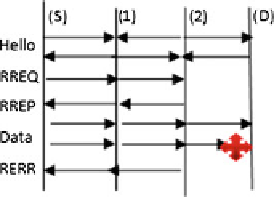Biomedical Engineering Reference
In-Depth Information
distance vector protocols by implementing a sequence number. Unlike DSR which
carries the entire route between the source and destination in the packet, the nodes
in AODV carry only the next hop information corresponding to each data flow.
Being a reactive routing protocol route is discovered as when needed and the
discovered routes are maintained as long as they are required.
A route discovery is initiated [
4
] when one of the nodes in the network wants to
send a data packet to another node. If an active route is not available AODV
initiates the route discovery process with the source node broadcasting a route
request message (RREQ) to find a route to the destination. The route is found
either with the RREQ reaching the destination or an intermediate node in the
network which has ''fresh enough'' route to the destination with the sequence
number equal to or greater than the sequence number contained in the RREQ.
Once a valid route is found it is made available by a route reply (RREP) message
back to the originator of the RREQ. Once the route is established the nodes
monitor the state of the links continuously. If a link breaks in an active route, a
route error message (RERR) is sent to the other nodes of the link breakage. This
initiates a new route discovery process.
The advantages of AODV routing protocol are the selection of the least con-
gested route instead of the shortest path. AODV supports both uncast and multicast
data transmission. Performance is not drastically affected even if the topology
changes continuously. Since source routing is not used, there are no additional
overheads in the data.
Recent Work
There are so many developments that took place in an AODV routing protocols.
They are as follows:
1. Corson et al. [
6
] have presented a loop-free, distributed routing protocol for
mobile packet radio networks. The protocol was designed for networks, which
does not change too fast or near-static networks. The objective of the routing
algorithm was to build routes only when necessary and to build them quickly
before topology changes. The proposed protocol maintains source-initiated,

Search WWH ::

Custom Search